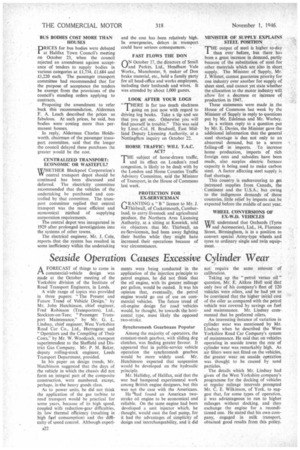Seaside Operation Causes Excessive Cylinder Wear
Page 24

If you've noticed an error in this article please click here to report it so we can fix it.
A FORECAST of things to come in
commercial-vehicle design was made at the October meeting of the Yorkshire division of the Institute of Road Transport Engineers, in Leeds. A wide range of topics was provided in three papers: "The Present and Future Trend of Vehicle Design," by Mr. John Hutchinson, chief engineer. Fred Robinson (Transporters), Ltd., Stockton-on-Tees; "Passenger Transport Maintenance," by Mr. G. L. Lindsay, chief engineer, West Yorkshire Road Car Co., Ltd., Harrogate; and " Operators and the Compiling of Their Costs," by Mr. W. Woodcock, transport superintendent to the Sheffield and District Gas Company. Mr. P. M. Baker, deputy rolling-stock engineer, Leeds Transport Department, presided.
In his. paper on design trends, Mr. Hutchinson suggested that the days of the vehicle in which the chassis did not form an integral part of the composite construction, were numbered, except, perhaps, in the heavy goods class.
As to power units, he did not think the application of the gas turbine to road transport would be practical for some years, because of its high speed, coupled with reduction-gear difficulties. its low thermal efficiency (resulting in high fael consumption) and the diffi
culty of speed control. Although experi.
ments were being conducted in the application of the injection principle to petrol engines, he did not think that the oil engine, with its greater mileage per gallon, would be ousted. It was his opinion that, eventually, the petrol engine would go out of use on commercial vehicles. The future trend of oil-engine design for road vehicles would. he thought, be -towards the horizontal. type, most likely the opposed two-stroke.
Synchromesh Gearboxes Popular Among the majority of operators, the constant-mesh gearbox, with sliding dog clutches, was finding greater favour. It appeared that in public-service vehicle operation the synchromesh gearbox would be more widely used. Mr. Hutchinson expected that suspension would be developed on the hydraulic principle.
Mr. Halliday, of Halifax. said that the war had hampered experimental work among British engine designers, but this was not the case with the Americans. He had found an American twostroke oil engine to be economical and reliable. On the same engine had been developed a unit injector which, he , thought, would oust the fuel pump, for it had the advantages of simplicity of design and interchangeability, and it did
not require the same amount of calibration.
Taking up the "petrol versus oil" question, Mr. E. Aitken Hull said that only two of his company's fleet of 120 vehicles were oilers, and he had yet to be convinced that the higher initial cost of the oiler as compared with the petrol vehicle was covered by savings on fuel and maintenance. Mr. Lindsay com-. mented that he preferred oilers.
An interesting instance of variation in cylinder wear was mentioned by Mr. Lindsay when he described the West Yorkshire Road Car Company's system of maintenance. He said that on vehicles operating in seaside towns the rate of cylinder wear was remarkably high. As air filters were not fitted on the vehicles, the greater wear on seaside operation was thought to be caused by sand particles.
The details which Mr. Lindsay had given of the West Yorkshire company's programme for the docking of vehicles at regular mileage intervals prompted Mr. C. E. Wilkinson, of York, to suggest that, for some types of operation. it was advantageous to run to higher mileages without docking, and• then exchange the engine for a reconditioned one. He stated that his own company. engaged . in milk transport. obtained good results from this policy.




































































